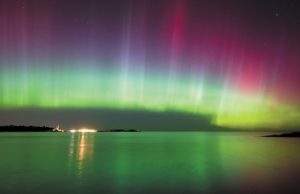July 31, 2017
August 2017 – Look to the Sky
 By Eloise Graham
By Eloise Graham
The August sky is full of many marvels. This year, the Northern Lights are at the peak of its cycle of activity. We can probably not catch a glimpse of them here in the Quad Cities, but if you have planned a trip to the northern states or Canada during the second week of August, keep an eye on the sky! The August sky is full of many marvels. This year, the Northern Lights are at the peak of its cycle of activity. We can probably not catch a glimpse of them here in the Quad Cities, but if you have planned a trip to the northern states or Canada during the second week of August, keep an eye on the sky!
The moon is taking center stage! There is a full moon on August 7. There will also be a partial lunar eclipse. This happens when the moon passes through the Earth’s partial shadow. Unfortunately, we will not see the eclipse on this side of the hemisphere.
Just some trivia about an August full moon. The full August Moon was known by the early Native Americans as the Full Sturgeon Moon because the large sturgeon fish of the Great Lakes and other major lakes were more easily caught at this time of year. Other monikers given to this full moon are Green Corn Moon and Grain Moon.
August 11, 12 and early morning hours of 13 are the dates for the Perseids Meteor show. However, the moon is still getting in the act. It will be a 3/4 moon and will rise shortly before the peak of the meteor shower. But many of the brighter meteors will be visible and should still provide a spectacular show. Best viewing will be from a dark location (away from the city lights) and probably late night or after midnight. The meteors will radiate from the constellation Perseus and can appear anywhere in the sky.
 August 21 will be the big show! The moon will be a new moon (that means it is all dark). It will be located on the same side of the Earth as the Sun but will not be visible in the night sky. New moon phase is the best time to observe other faint objects such as galaxies and star clusters because there is no moonlight to interfere with the viewing. However, the really big show is the total eclipse of the Sun. This occurs when the moon completely blocks out the Sun. This is a rare event for viewers in the United States. The last total solar eclipse visible in the continental United States was in 1979. The last solar eclipse to travel coast to coast was in 1918. The path, and it is a narrow one, will originate in the Pacific Ocean and travel through the center of the United States before ending in the Atlantic Ocean. The total eclipse will be visible in parts of Oregon, Idaho, Wyoming, Nebraska, Missouri, Kentucky, Tennessee, North and South Carolinas. Omaha and Kansas City are in the direct path. We will get a partial eclipse here, the first band outside of the total area, so it will definitely grow darker as the moon passes through the path of the Sun.
August 21 will be the big show! The moon will be a new moon (that means it is all dark). It will be located on the same side of the Earth as the Sun but will not be visible in the night sky. New moon phase is the best time to observe other faint objects such as galaxies and star clusters because there is no moonlight to interfere with the viewing. However, the really big show is the total eclipse of the Sun. This occurs when the moon completely blocks out the Sun. This is a rare event for viewers in the United States. The last total solar eclipse visible in the continental United States was in 1979. The last solar eclipse to travel coast to coast was in 1918. The path, and it is a narrow one, will originate in the Pacific Ocean and travel through the center of the United States before ending in the Atlantic Ocean. The total eclipse will be visible in parts of Oregon, Idaho, Wyoming, Nebraska, Missouri, Kentucky, Tennessee, North and South Carolinas. Omaha and Kansas City are in the direct path. We will get a partial eclipse here, the first band outside of the total area, so it will definitely grow darker as the moon passes through the path of the Sun.


